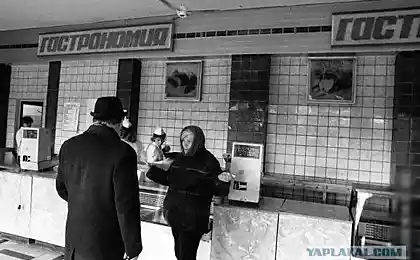211
Open stew forty years ago, which was stored in the basement since the Soviet Union
“Sometimes I was getting rid of unnecessary rubbish in the country house and dug up two whole tin cans of stew in the basement of the house. And it is interesting that one was still 1976 year of release, and the other relatively fresh – only a couple of years.
Curiosity took over and I decided to research the contents. A bank from 40 years ago opened surprisingly easily. The metal containers at that time were made strong and of high quality.”
“The jar itself was completely filled with stew with an amazing aroma. The fat was very small, in moderation. Not like now, when it's more than half. I wasn't afraid, I tried. The stew is not spoiled.”
View this post on Instagram
Beef stew. From Rosrezerv. Highest grade, Guest. W / b, without a key, weight 325 grams Delicious, fragrant, excellent meat bookmark. Cost by volume (quantity) of order. #stewed beef #stew #stew #stew #meat stew #stew #stew #stew #stew meat #delivery of stew #delivery of stewed meat #meat-eater #soup-extinguishing #paste #paste-stew #stewedspot #stewedkagovyad #favourite #favourite
Publication from Caviar, Fish, Seafood (@ikra_pro) 5 April 2020 at 12:22 PDT
“But the modern stew, I will call it that, did not please at all. Opened - inside floats something liquid and incomprehensible. Even the dog was afraid to give so that nothing would happen to it.”
“But why is that so?” Have you forgotten how to make quality products for people? They can come up with a beautiful label, bright, interesting. And you open - inside it is not clear what, the man indignant.
After reading this story, we are in the editorial office. "Site" We decided to remember the history of the appearance of stew in the light. And also try to understand why lately high-quality and tasty stew has become rare.
Even in ancient times, people thought how to save food for a long time for their needs or family needs. However, close to the modern method of canning meat was invented only in 1804 by the French confectioner Nicolas François Upper.

For his invention, he even received from Napoleon Bonaparte an honorary title and a large monetary reward (about 400 thousand euros in terms of modern exchange rates). After all, with the help of canned food, the French emperor could solve the problem of feeding his army of thousands.
By the way, later Louis Pasteur will develop his famous pasteurization technology, using Apper’s idea: to heat the product to 110-120 degrees without oxygen.
In the 1820s, the British became interested in canned food. Already in 1826, England acquired a patent and established the production of canned food, including them in the diet of its soldiers. However, the “package” of that time was much stronger than the current one. And to open the jar, the soldiers had to wield a chisel and a hammer.
View this post on Instagram
This is not a review, this stew is not sold in the store, it's more a discussion on why I don't buy stew in the store. If you buy something cheaper, it immediately flies into the trash, I bought last year for reviewers a couple of times. If you take it more expensive, it'll probably be edible, but there's a hell of a thing. There is no money for such a product. Instead of expensive stew, you can buy some minced pork and make delicious gravy. For a hike, buying stew is a good option, but try to find a good one for an adequate price. I have long been disappointed in this product, but friends brought me a jar of homemade stew made of wild boar and deer meat. That's what I mean by stew, clean meat, no horns and no hooves. There's fat and jelly, but not much. There is a slight spiciness, this is really tasty. This should be the stew, not what they sell in the store. #instafood #foodlover #foodpic #foodanddrinksinlatvia #edaindrinks #fooddrinksvlatvia #foodsvlatvia #to buy Latvia #riga #riga #riga #rīga #Latvia #latvija #madeinlatvia #ražotslatvija #madeLatvia #ražotslatvija #madeLatvia #products #cans #cannedies #me canned meat cans #stew #stew #memememememesabana #memesalter
Publication from Food & Drinks in Latvia (@foodinlv) 2 September 2020 at 11:52 PDT
In Russia, the first cannery appeared only in 1870. And the products were supplied precisely for the needs of the army. The most acceptable food was considered stewed beef, which retained the taste and was the most tasty food from a tin can. The name “stew” was firmly established at the end of the XIX century.
In the First World War, Russian canneries produced 5 types of stew. The main customer, of course, was the army. And for millions of soldiers, frozen delicious stew in ice dugouts was a real salvation.
"Self-heating stew" Interestingly, in 1897, engineer Evgeny Fedorov invented a self-heating can. Such a container had a double bottom. When turning, a special tank was filled with water and quicklime. Therefore, when mixing, enough heat was released for heating.
View this post on Instagram
#vintage#sssr#stashkassr
Posting by lev (@russlavjr) 4 March 2019 at 7:58 PST
This “self-heating” delicious stew was very useful at the front. After all, it was not safe to make a fire with fire and smoke in military conditions. However, due to the complexity of the design, we did not mass produce such banks. But the Germans were so impressed with this invention that by the next military campaign they had established their own production of similar products.
As for the durability of war stew, then it is worth remembering one story. In 1966, an elderly man brought to the All-Union Research Institute of the Canning Industry a canned can of the Petropavlovsk Cannery of 1916.
It turned out that his grandfather received it at the front during the First World War. Scientists conducted an analysis and confirmed that meat not only can be eaten, but it is also perfectly preserved, although half a century was in the jar.
After the collapse of the USSR, some began to sell stew from military warehouses, while others began to establish the production of new products. However, few people have looked at the standards of the past. Cute manufacturers quickly learned to bypass quality control to sell a cheap, but very profitable for the production of “stew”.
View this post on Instagram
turkey stew. I present you a stew of domestic turkey cooked in an autoclave. The stew turned out tender, almost without fat and very tasty. Stewed turkey meat does not lose its qualities when canning, and my stew, unlike store stew, does not contain harmful impurities and preservatives. It tastes great! The cost of the bank is 0.7 liters - rubles. 0.5 l. - RUB. Saving vitamins for the winter! Self-delivery from the village of Raevskaya. On delivery to Novorossiysk / Anapa write to Direct or Vatsapp#Rayevsky Raznosols#preservevitamininazim #Rayevsky pickles#saw #stool#compots#tkemali#ajika#ketchup#solyanovorossiy#rayevskaya#anapa#Krasnodar region#farmeric products#stewkaisavtoklava#natural products without preservative colorants
Publication from RAEWS DIFFERENCES. (@raevskie_raznosoly) 18 Oct 2020 at 6:08 PDT
So what do we do as ordinary consumers? Trust only proven producers of canned food, which have already managed to prove themselves from the good side. It is even better to cook the stew yourself. Especially since it is not as difficult as it may seem at first glance.
Photo in article
Curiosity took over and I decided to research the contents. A bank from 40 years ago opened surprisingly easily. The metal containers at that time were made strong and of high quality.”
“The jar itself was completely filled with stew with an amazing aroma. The fat was very small, in moderation. Not like now, when it's more than half. I wasn't afraid, I tried. The stew is not spoiled.”
View this post on Instagram
Beef stew. From Rosrezerv. Highest grade, Guest. W / b, without a key, weight 325 grams Delicious, fragrant, excellent meat bookmark. Cost by volume (quantity) of order. #stewed beef #stew #stew #stew #meat stew #stew #stew #stew #stew meat #delivery of stew #delivery of stewed meat #meat-eater #soup-extinguishing #paste #paste-stew #stewedspot #stewedkagovyad #favourite #favourite
Publication from Caviar, Fish, Seafood (@ikra_pro) 5 April 2020 at 12:22 PDT
“But the modern stew, I will call it that, did not please at all. Opened - inside floats something liquid and incomprehensible. Even the dog was afraid to give so that nothing would happen to it.”
“But why is that so?” Have you forgotten how to make quality products for people? They can come up with a beautiful label, bright, interesting. And you open - inside it is not clear what, the man indignant.
After reading this story, we are in the editorial office. "Site" We decided to remember the history of the appearance of stew in the light. And also try to understand why lately high-quality and tasty stew has become rare.
Even in ancient times, people thought how to save food for a long time for their needs or family needs. However, close to the modern method of canning meat was invented only in 1804 by the French confectioner Nicolas François Upper.

For his invention, he even received from Napoleon Bonaparte an honorary title and a large monetary reward (about 400 thousand euros in terms of modern exchange rates). After all, with the help of canned food, the French emperor could solve the problem of feeding his army of thousands.
By the way, later Louis Pasteur will develop his famous pasteurization technology, using Apper’s idea: to heat the product to 110-120 degrees without oxygen.
In the 1820s, the British became interested in canned food. Already in 1826, England acquired a patent and established the production of canned food, including them in the diet of its soldiers. However, the “package” of that time was much stronger than the current one. And to open the jar, the soldiers had to wield a chisel and a hammer.
View this post on Instagram
This is not a review, this stew is not sold in the store, it's more a discussion on why I don't buy stew in the store. If you buy something cheaper, it immediately flies into the trash, I bought last year for reviewers a couple of times. If you take it more expensive, it'll probably be edible, but there's a hell of a thing. There is no money for such a product. Instead of expensive stew, you can buy some minced pork and make delicious gravy. For a hike, buying stew is a good option, but try to find a good one for an adequate price. I have long been disappointed in this product, but friends brought me a jar of homemade stew made of wild boar and deer meat. That's what I mean by stew, clean meat, no horns and no hooves. There's fat and jelly, but not much. There is a slight spiciness, this is really tasty. This should be the stew, not what they sell in the store. #instafood #foodlover #foodpic #foodanddrinksinlatvia #edaindrinks #fooddrinksvlatvia #foodsvlatvia #to buy Latvia #riga #riga #riga #rīga #Latvia #latvija #madeinlatvia #ražotslatvija #madeLatvia #ražotslatvija #madeLatvia #products #cans #cannedies #me canned meat cans #stew #stew #memememememesabana #memesalter
Publication from Food & Drinks in Latvia (@foodinlv) 2 September 2020 at 11:52 PDT
In Russia, the first cannery appeared only in 1870. And the products were supplied precisely for the needs of the army. The most acceptable food was considered stewed beef, which retained the taste and was the most tasty food from a tin can. The name “stew” was firmly established at the end of the XIX century.
In the First World War, Russian canneries produced 5 types of stew. The main customer, of course, was the army. And for millions of soldiers, frozen delicious stew in ice dugouts was a real salvation.
"Self-heating stew" Interestingly, in 1897, engineer Evgeny Fedorov invented a self-heating can. Such a container had a double bottom. When turning, a special tank was filled with water and quicklime. Therefore, when mixing, enough heat was released for heating.
View this post on Instagram
#vintage#sssr#stashkassr
Posting by lev (@russlavjr) 4 March 2019 at 7:58 PST
This “self-heating” delicious stew was very useful at the front. After all, it was not safe to make a fire with fire and smoke in military conditions. However, due to the complexity of the design, we did not mass produce such banks. But the Germans were so impressed with this invention that by the next military campaign they had established their own production of similar products.
As for the durability of war stew, then it is worth remembering one story. In 1966, an elderly man brought to the All-Union Research Institute of the Canning Industry a canned can of the Petropavlovsk Cannery of 1916.
It turned out that his grandfather received it at the front during the First World War. Scientists conducted an analysis and confirmed that meat not only can be eaten, but it is also perfectly preserved, although half a century was in the jar.
After the collapse of the USSR, some began to sell stew from military warehouses, while others began to establish the production of new products. However, few people have looked at the standards of the past. Cute manufacturers quickly learned to bypass quality control to sell a cheap, but very profitable for the production of “stew”.
View this post on Instagram
turkey stew. I present you a stew of domestic turkey cooked in an autoclave. The stew turned out tender, almost without fat and very tasty. Stewed turkey meat does not lose its qualities when canning, and my stew, unlike store stew, does not contain harmful impurities and preservatives. It tastes great! The cost of the bank is 0.7 liters - rubles. 0.5 l. - RUB. Saving vitamins for the winter! Self-delivery from the village of Raevskaya. On delivery to Novorossiysk / Anapa write to Direct or Vatsapp#Rayevsky Raznosols#preservevitamininazim #Rayevsky pickles#saw #stool#compots#tkemali#ajika#ketchup#solyanovorossiy#rayevskaya#anapa#Krasnodar region#farmeric products#stewkaisavtoklava#natural products without preservative colorants
Publication from RAEWS DIFFERENCES. (@raevskie_raznosoly) 18 Oct 2020 at 6:08 PDT
So what do we do as ordinary consumers? Trust only proven producers of canned food, which have already managed to prove themselves from the good side. It is even better to cook the stew yourself. Especially since it is not as difficult as it may seem at first glance.
Photo in article
What the inimitable satirist Mikhail Zhvanetsky left as a legacy
Test to revive memory and recall the Soviet past in detail























